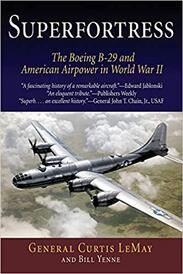Boeing B-29 Super-Fortress
|
"The Boeing B-29 Superfortress is a four-engine propeller-driven heavy bomber designed by Boeing and flown primarily by the United States during World War II and the Korean War. Named in allusion to its predecessor, the B-17 Flying Fortress, the Superfortress was designed for high-altitude strategic bombing but also excelled in low-altitude night incendiary bombing. B-29s also dropped the atomic bombs on Hiroshima and Nagasaki which led to the end of World War II.
One of the largest aircraft of World War II, the B-29 had state-of-the-art technology, including a pressurized cabin; dual-wheeled, tricycle landing gear; and an analog computer-controlled fire-control system that allowed one gunner and a fire-control officer to direct four remote machine gun turrets. The $3 billion cost of design and production (equivalent to $42 billion today)—far exceeding the $1.9 billion cost of the Manhattan Project—made the B-29 program the most expensive of the war. In September 1941, the Army Air Forces plans for war against Germany and Japan proposed basing the B-29 in Egypt for operations against Germany as British airbases were likely to be overcrowded. Air Force planning throughout 1942 and early 1943 continued to have the B-29 deployed initially against Germany, only transferring to the Pacific after the end of the war in Europe. By the end of 1943, however, plans had changed, partly due to production delays, and the B-29 was dedicated to the Pacific Theater. A new plan implemented at the direction of President Franklin D. Roosevelt as a promise to China, called Operation Matterhorn, deployed the B-29 units to attack Japan from four forward bases in southern China, with five main bases in India, and to attack other targets in the region from China and India as needed. |
|
This was an extremely costly scheme, as there was no overland connection available between India and China, and all supplies had to be flown over the Himalayas, either by transport aircraft or by the B-29s themselves, with some aircraft being stripped of armor and guns and used to deliver fuel. B-29s started to arrive in India in early April 1944. The first B-29 flight to airfields in China (over the Himalayas, or "The Hump") took place on 24 April 1944. The first B-29 combat mission was flown on 5 June 1944, with 77 out of 98 B-29s launched from India bombing the railroad shops in Bangkok and elsewhere in Thailand. Five B-29s were lost during the mission, none to hostile fire."
Source: Wikipedia
Source: Wikipedia
Books
